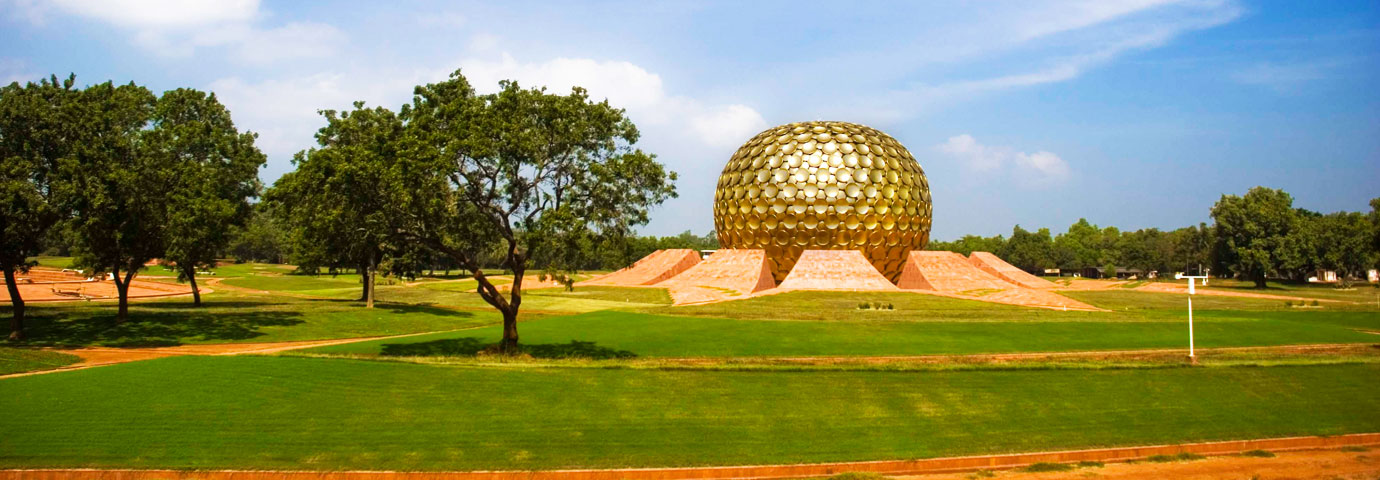Auroville, which means the 'City of Dawn', was founded by Sri Aurobindo's mother on February 28, 1968. The disciple and spiritual collaborator of Sri Aurobindo, she had built up the Ashram into a multi-faceted, spiritual community and had established the Sri Aurobindo International Center for Education earlier.
Auroville is meant to be "a universal town where men and women of all countries are able to live in peace and progressive harmony above all creeds, all politics and all nationalities. The purpose of Auroville is to realize human unity," said the Mother in 1965. Three years later at the inauguration ceremony of Auroville on February 28, 1968 young boys and girls representing 121 nations and 23 Indian states placed a handful of earth from their part of the world in a lotus-shaped urn, symbolizing the creation of a city dedicated to peace, international understanding and a hopeful future for humanity. That was the beginning.
History
At the center of Auroville is the Matri Mandir described as 'the soul of Auroville'. The main building is a flattened sphere, 36 meters in diameter, within which is located the 'Inner Room' visualized by the Mother. It is a place "for concentration and … for trying to find one's consciousness." In the hall with the crystal globe-the largest single crystal in the world-everything is in white. There are no flowers, no incense and no music because the Mother did not wish it to be a typically religious place: "there must be absolutely no dogmas, nor rules, nor rituals". Here amidst total silence, people are free to sit anywhere for quiet meditation. It is open to visitors (who have to obtain a pass) between 4 p.m. and 5 p.m. every day.
Tourists Attractions
The Matri Mandir is surrounded by four zones: the cultural, international, industrial, and residential. The Cultural Zone has educational, cultural and sports activities as its focus. It consists of schools, a sports complex, and a youth center. A centralized structure (Sri Aurobindo International Institute of Educational Research), which is involved in research on new teaching methods while recognizing traditional educational levels, coordinates the whole system of education in Auroville. The sports complex provides facilities for tennis, football, handball, and riding. Cultural activities include drama, musical and dance programs. The International Zone in meant to be like an international campus, a place for events, and a meeting place for compatriots.
The Industrial Zone has money-generating units for Auroville, which aims to be a self-supporting city. It has several industries such as food processing units and concerns such as jam and pickle making, bakeries, manufacturing readymade garments, assembling electronic components, and so on. The Residential Zone includes structures, which range from huts to individual houses and apartments. However, the individuals do not own the houses. They belong to Auroville. A central community kitchen caters for all Aurovilians though there are some separate community kitchens as well. Auroville is now an expanding community of nearly 2,000 people from Indian and some 30 countries around the world. The Auroville residents have created a basic infrastructure of roads, water, electricity and telecommunications, including an electronic communication network.
Green Drive - The site of Auroville was once a backward and impoverished rural area, surrounded by 13 villages with a population of over 40,000 people. Bare and eroded, it was mainly wasteland. A number of Aurovilians took up the task of 'bringing this land back to life' with the help of these villagers. After twenty years of hard work, they have succeeded in regenerating the soil on a long-term basis through biological farming methods without using any artificial fertilizers or chemical products. The two million trees planted by them on 2,800 acres of once-arid land have successfully created a lush green belt, which is beautiful to behold.
Ashram - Outsiders often wonder how the Sri Aurobindo Ashram and Auroville are related. While the Mother founded both on the ideals of Sri Aurobindo, the two are separate legal entities that have been evolving independently. Broadly speaking, while the Ashram focuses on the inner development and transformation of individuals, Auroville's focus is the creation of a new society and city, which is global and universal, belonging to humanity as a whole.
The Ashram, which originally comprised a small group of two-dozen disciples, has now grown into a large community with over 1,200 members, around 400 students belonging to the Center of Education and hundreds of devotees who live nearby. Sri Aurobindo had said, "This Ashram has been created … not for the renunciation of the world but as a center and a field of practice for another kind and form of life which would, in the end, be moved by a higher spiritual consciousness and embody a greater life of the spirit". In keeping with his words, the Ashram is not a quiet place of retreat secluded from the world but a vibrant center of life in a busy, urban setting. Work here is essentially karma yoga-an offering to the Divine. There is no obligatory practices, no rituals, no compulsory meditations, or systematic instructions in yoga. Each devotee is free to determine the kind and pace of his/her sadhana and decide what work he or she wants to do.
Auroville is 160 km south of Chennai, and 10 kilometers from Pondicherry. There are buses plying regularly from Madras, Bangalore, Ooty, Madurai, Kanchipuram and Mahabalipuram. The best way to get around is by bicycle, which can be hired in Pondicherry.


